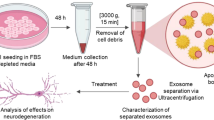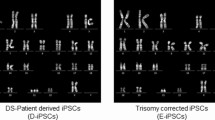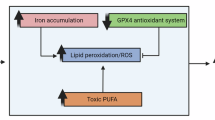Abstract
Strong evidence indicates oxidative stress in the pathogenesis of Alzheimer's disease (AD). Amyloid β (Aβ) has been implicated in both oxidative stress mechanisms and in neuronal apoptosis. Glutaredoxin-1 (GRX1) and thioredoxin-1 (TRX1) are antioxidants that can inhibit apoptosis signal-regulating kinase (ASK1). We examined levels of GRX1 and TRX1 in AD brain as well as their effects on Aβ neurotoxicity. We show an increase in GRX1 and a decrease in neuronal TRX1 in AD brains. Using SH-SY5Y cells, we demonstrate that Aβ causes an oxidation of both GRX1 and TRX1, and nuclear export of Daxx, a protein downstream of ASK1. Aβ toxicity was inhibited by insulin-like growth factor-I (IGF-I) and by overexpressing GRX1 or TRX1. Thus, Aβ neurotoxicity might be mediated by oxidation of GRX1 or TRX1 and subsequent activation of the ASK1 cascade. Deregulation of GRX1 and TRX1 antioxidant systems could be important events in AD pathogenesis.
Similar content being viewed by others
Log in or create a free account to read this content
Gain free access to this article, as well as selected content from this journal and more on nature.com
or
Abbreviations
- Aβ:
-
amyloid β
- AD:
-
Alzheimer's disease
- AMS:
-
4-acetamido-4′-maleimidyl-stilbene-2,2′-disulfonate
- ASK1:
-
apoptosis signal-regulating kinase 1
- BCA:
-
bicinchoninic acid
- CERAD:
-
Consortium to establish a Registry for Alzheimer's disease
- Daxx:
-
death-associated protein
- DSM-IV:
-
Diagnostic and Statistical Manual of Mental Disorders-IV
- DTT:
-
dithiothreitol
- ERK:
-
extracellular signal-regulated kinase
- GFAP:
-
glial fibrillary acidic protein
- GRX1:
-
glutaredoxin 1
- GSH:
-
reduced glutathione
- GSSG:
-
oxidized glutathione
- HIV:
-
human immunodeficiency virus
- IGF-I:
-
insulin-like growth factor-I
- JNK:
-
c-Jun N-terminal kinase
- MAPKKK:
-
mitogen-activated protein kinase kinase kinase
- MCB:
-
monochlorobimane
- MEM:
-
minimum essential medium
- MTT:
-
3-(4,5-dimethyl-2-thiazolyl)-2,5-diphenyl-2H-tetrazolium bromide
- ORF:
-
open reading frame
- PI3K:
-
phosphatidylinositol 3-kinase
- PLSD:
-
post least significant distance
- PMSF:
-
phenylmethylsulfonyl fluoride
- TCA:
-
trichloroacetic acid
- TRX1:
-
thioredoxin 1
- TRXR:
-
thioredoxin reductase
References
Hardy JA and Higgins GA (1992) Alzheimer's disease: the amyloid cascade hypothesis. Science 256: 184–185
Huang X, Moir RD, Tanzi RE, Bush AI and Rogers JT (2004) Redox-active metals, oxidative stress, and Alzheimer's disease pathology. Ann. N. Y. Acad. Sci. 1012: 153–163
Small DH, Mok SS and Bornstein JC (2001) Alzheimer's disease and Abeta toxicity: from top to bottom. Nat. Rev. Neurosci. 2: 595–598
LaFerla FM, Tinkle BT, Bieberich CJ, Haudenschild CC and Jay G (1995) The Alzheimer's A beta peptide induces neurodegeneration and apoptotic cell death in transgenic mice. Nat. Genet. 9: 21–30
Stadelmann C, Deckwerth TL, Srinivasan A, Bancher C, Bruck W, Jellinger K and Lassmann H (1999) Activation of caspase-3 in single neurons and autophagic granules of granulovacuolar degeneration in Alzheimer's disease. Evidence for apoptotic cell death. Am. J. Pathol. 155: 1459–1466
Holmgren A (2000) Antioxidant function of thioredoxin and glutaredoxin systems. Antioxid. Redox Signal. 2: 811–820
Ichijo H, Nishida E, Irie K, ten Dijke P, Saitoh M, Moriguchi T, Takagi M, Matsumoto K, Miyazono K and Gotoh Y (1997) Induction of apoptosis by ASK1, a mammalian MAPKKK that activates SAPK/JNK and p38 signaling pathways. Science 275: 90–94
Song JJ and Lee YJ (2003) Differential role of glutaredoxin and thioredoxin in metabolic oxidative stress-induced activation of apoptosis signal-regulating kinase 1. Biochem. J. 373: 845–853
Song JJ and Lee YJ (2003) Role of the ASK1-SEK1-JNK1-HIPK1 signal in Daxx trafficking and ASK1 oligomerization. J. Biol. Chem. 278: 47245–47252
Daily D, Vlamis-Gardikas A, Offen D, Mittelman L, Melamed E, Holmgren A and Barzilai A (2001) Glutaredoxin protects cerebellar granule neurons from dopamine-induced apoptosis by dual activation of the ras-phosphoinositide 3-kinase and jun n-terminal kinase pathways. J. Biol. Chem. 276: 21618–21626
Lovell MA, Xie C, Gabbita SP and Markesbery WR (2000) Decreased thioredoxin and increased thioredoxin reductase levels in Alzheimer's disease brain. Free Radic. Biol. Med. 28: 418–427
Kadowaki H, Nishitoh H, Urano F, Sadamitsu C, Matsuzawa A, Takeda K, Masutani H, Yodoi J, Urano Y, Nagano T and Ichijo H (2005) Amyloid beta induces neuronal cell death through ROS-mediated ASK1 activation. Cell Death Differ. 12: 19–24
Ginsberg SD, Hemby SE, Lee VM, Eberwine JH and Trojanowski JQ (2000) Expression profile of transcripts in Alzheimer's disease tangle-bearing CA1 neurons. Ann. Neurol. 48: 77–87
Asahina M, Yamada T, Yoshiyama Y and Yodoi J (1998) Expression of adult T cell leukemia-derived factor in human brain and peripheral nerve tissues. Dement. Geriatr. Cogn. Disord. 9: 181–185
Esiri M and Oppenheimer DR (1996) In Oppenheimer's Diagnostic Neuropathology: a Practical Manual (Oxford: Blackwell Science) pp. 51–77
Beach TG, Walker R and McGeer EG (1989) Patterns of gliosis in Alzheimer's disease and aging cerebrum. Glia 2: 420–436
Galvan V, Logvinova A, Sperandio S, Ichijo H and Bredesen DE (2003) Type 1 insulin-like growth factor receptor (IGF-IR) signaling inhibits apoptosis signal-regulating kinase 1 (ASK1). J. Biol. Chem. 278: 13325–13332
Wei W, Wang X and Kusiak JW (2002) Signaling events in amyloid beta-peptide-induced neuronal death and insulin-like growth factor I protection. J. Biol. Chem. 277: 17649–17656
Lovell MA, Ehmann WD, Butler SM and Markesbery WR (1995) Elevated thiobarbituric acid-reactive substances and antioxidant enzyme activity in the brain in Alzheimer's disease. Neurology 45: 1594–1601
Marcus DL, Thomas C, Rodriguez C, Simberkoff K, Tsai JS, Strafaci JA and Freedman ML (1998) Increased peroxidation and reduced antioxidant enzyme activity in Alzheimer's disease. Exp. Neurol. 150: 40–44
Lippoldt A, Padilla CA, Gerst H, Andbjer B, Richter E, Holmgren A and Fuxe K (1995) Localization of thioredoxin in the rat brain and functional implications. J. Neurosci. 15: 6747–6756
Grant CM (2001) Role of the glutathione/glutaredoxin and thioredoxin systems in yeast growth and response to stress conditions. Mol. Microbiol. 39: 533–541
Yamagata K, Tagami M, Ikeda K, Yamori Y and Nara Y (2000) Altered gene expressions during hypoxia and reoxygenation in cortical neurons isolated from stroke-prone spontaneously hypertensive rats. Neurosci. Lett. 284: 131–134
Hirota K, Matsui M, Murata M, Takashima Y, Cheng FS, Itoh T, Fukuda K and Yodoi J (2000) Nucleoredoxin, glutaredoxin, and thioredoxin differentially regulate NF-kappaB, AP-1, and CREB activation in HEK293 cells. Biochem. Biophys. Res. Commun. 274: 177–182
Saitoh M, Nishitoh H, Fujii M, Takeda K, Tobiume K, Sawada Y, Kawabata M, Miyazono K and Ichijo H (1998) Mammalian thioredoxin is a direct inhibitor of apoptosis signal-regulating kinase (ASK) 1. EMBO J. 17: 2596–2606
Miranda-Vizuete A, Rodriguez-Ariza A, Toribio F, Holmgren A, Lopez-Barea J and Pueyo C (1996) The levels of ribonucleotide reductase, thioredoxin, glutaredoxin 1, and GSH are balanced in Escherichia coli K12. J. Biol. Chem. 271: 19099–19103
Garrido EO and Grant CM (2002) Role of thioredoxins in the response of Saccharomyces cerevisiae to oxidative stress induced by hydroperoxides. Mol. Microbiol. 43: 993–1003
Ramassamy C, Averill D, Beffert U, Bastianetto S, Theroux L, Lussier-Cacan S, Cohn JS, Christen Y, Davignon J, Quirion R and Poirier J (1999) Oxidative damage and protection by antioxidants in the frontal cortex of Alzheimer's disease is related to the apolipoprotein E genotype. Free Radic. Biol. Med. 27: 544–553
Cardoso SM and Oliveira CR (2003) Glutathione cycle impairment mediates A beta-induced cell toxicity. Free Radic. Res. 37: 241–250
Chang HY, Nishitoh H, Yang X, Ichijo H and Baltimore D (1998) Activation of apoptosis signal-regulating kinase 1 (ASK1) by the adapter protein Daxx. Science 281: 1860–1863
Tobiume K, Matsuzawa A, Takahashi T, Nishitoh H, Morita K, Takeda K, Minowa O, Miyazono K, Noda T and Ichijo H (2001) ASK1 is required for sustained activations of JNK/p38 MAP kinases and apoptosis. EMBO Rep. 2: 222–228
Kim AH, Khursigara G, Sun X, Franke TF and Chao MV (2001) Akt phosphorylates and negatively regulates apoptosis signal-regulating kinase 1. Mol. Cell. Biol. 21: 893–901
Kenchappa RS, Diwakar L, Boyd MR and Ravindranath V (2002) Thioltransferase (glutaredoxin) mediates recovery of motor neurons from excitotoxic mitochondrial injury. J. Neurosci. 22: 8402–8410
Takagi Y, Mitsui A, Nishiyama A, Nozaki K, Sono H, Gon Y, Hashimoto N and Yodoi J (1999) Overexpression of thioredoxin in transgenic mice attenuates focal ischemic brain damage. Proc. Natl. Acad. Sci. U.S.A. 96: 4131–4136
Cedazo-Minguez A, Popescu BO, Blanco-Millan JM, Akterin S, Pei JJ, Winblad B and Cowburn RF (2003) Apolipoprotein E and beta-amyloid (1–42) regulation of glycogen synthase kinase-3beta. J. Neurochem. 87: 1152–1164
Ferrari A, Hoerndli F, Baechi T, Nitsch RM and Gotz J (2003) Beta-amyloid induces paired helical filament-like tau filaments in tissue culture. J. Biol. Chem. 278: 40162–40168
Mirra SS, Heyman A, McKeel D, Sumi SM, Crain BJ, Brownlee LM, Vogel FS, Hughes JP, van Belle G and Berg L (1991) The Consortium to Establish a Registry for Alzheimer's Disease (CERAD). Part II. Standardization of the neuropathologic assessment of Alzheimer's disease. Neurology 41: 479–486
Simic G, Kostovic I, Winblad B and Bogdanovic N (1997) Volume and number of neurons of the human hippocampal formation in normal aging and Alzheimer's disease. J. Comp. Neurol. 379: 482–494
Trotter EW and Grant CM (2003) Non-reciprocal regulation of the redox state of the glutathione-glutaredoxin and thioredoxin systems. EMBO Rep. 4: 184–188
Johansson LH and Borg LA (1988) A spectrophotometric method for determination of catalase activity in small tissue samples. Anal. Biochem. 174: 331–336
Acknowledgements
We thank Inga Volkman and Anna Sandebring for their technical assistance. This research was supported by grants from the following Swedish foundations: Hjärnfonden (Swedish Brain Foundation), Gun och Bertil Stohnes Stiftelse, Karolinska Institutets Foundation for geriatric research, Loo and Hans Ostermans Foundation, Åke Wiberg Foundation, Svenska Lundbeck-stiftelsen, Demensförbundet, Alzheimer Foundation; Sweden, Lars Hiertas minnesstiftelse, Gamla Tjänarinnor foundation, Insamlingsstiftelsen för Alzheimer och demenforskning (SADF) and Swedish Brain Power project. AM-V was supported by Swedish Medical Research Council (Projects 03P-14096, 03X-14041, and 13X-10370). AJ was supported by a postdoctoral fellowship EX2003-0390 from the Spanish Ministerio de Educacion, Cultura y Deporte.
Author information
Authors and Affiliations
Corresponding author
Additional information
Edited by L Greene
Rights and permissions
About this article
Cite this article
Akterin, S., Cowburn, R., Miranda-Vizuete, A. et al. Involvement of glutaredoxin-1 and thioredoxin-1 in β-amyloid toxicity and Alzheimer's disease. Cell Death Differ 13, 1454–1465 (2006). https://doi.org/10.1038/sj.cdd.4401818
Received:
Revised:
Accepted:
Published:
Issue date:
DOI: https://doi.org/10.1038/sj.cdd.4401818
Keywords
This article is cited by
-
Serum Thioredoxin-80 is associated with age, ApoE4, and neuropathological biomarkers in Alzheimer’s disease: a potential early sign of AD
Alzheimer's Research & Therapy (2022)
-
Thioredoxin-1 inhibits amyloid-β25–35-induced activation of NLRP1/caspase-1/GSDMD pyroptotic pathway in PC12 cells
Molecular Biology Reports (2022)
-
Thioredoxin-80 protects against amyloid-beta pathology through autophagic-lysosomal pathway regulation
Molecular Psychiatry (2021)
-
Estrogen Signaling in Alzheimer’s Disease: Molecular Insights and Therapeutic Targets for Alzheimer’s Dementia
Molecular Neurobiology (2020)
-
Pathological role of apoptosis signal-regulating kinase 1 in human diseases and its potential as a therapeutic target for cognitive disorders
Journal of Molecular Medicine (2019)



